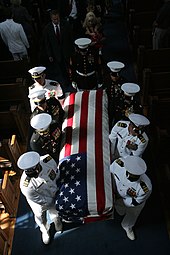Pallbearer


A pallbearer is one of several participants who help carry the casket at a funeral.
Some traditions distinguish between the roles of pallbearer and casket bearer. The former is a ceremonial position, carrying a tip of the pall or a cord attached to it. The latter do the actual heavy lifting and carrying. There may otherwise be pallbearers only in the symbolic sense if the casket is on an animal or vehicle.
In Western cultures, the pallbearers are usually male family members, close friends, or colleagues of the deceased. A notable exception was the funeral of Lee Harvey Oswald, in which reporters, pressed into service to carry the coffin, outnumbered the mourners.[1] In some Asian cultures, pallbearers are not to be members of the family but are outsiders, given a tip to perform the services of pallbearer.[citation needed]
At times additional pallbearers, known as Honorary Pallbearers, walk either behind or directly in front of the casket in a showcase of supplemental distinction towards the deceased. This type of pallbearer is most often a gentleman in the profession of the deceased who has achieved significant merit within their position.[2]
Etymology
A "pall" is a heavy cloth that is draped over a coffin.[3][4] Thus the term "pallbearer" is used to signify someone who "bears" the coffin which the pall covers.
Method of carrying
Pallbearers in the US and Canada most commonly carry a casket by the handles, and at around waist height.[5] In the United Kingdom, Australia, Ireland and most countries in Asia, the casket is often carried on the shoulders.[citation needed]
References
- ^ Cochran, Mike (21 November 2013). "How I became Lee Harvey Oswald's pallbearer". Denver Post. Associated Press. Retrieved 5 October 2015.
- ^ Taylor, Dorthy; Jacobsen, Linda (1969). Planning and Financing a Funeral (PDF). Texas A&M University, Agricultural Extension Service.
- ^ Herbermann, Charles, ed. (1913). . Catholic Encyclopedia. New York: Robert Appleton Company.
- ^ "Making Funeral Preparations: A Guide for Preparing Death and the Funeral Liturgy" (PDF). Evangelical Lutheran Church in America. p. 2. Retrieved 28 August 2014.
The coffin may be covered with a pall, recalling the white garment given in Baptism, the robe of Christ's righteousness that clothes us. The pall also reminds us that in death and before God all people are equal, regardless of whether the coffin is simple or elaborate. The white color of the pall is a reminder of Easter and Christ's victory over death.
- ^ "Funeral held for Canadian soldier killed in Afghanistan - Living - The Telegram". 25 September 2009. Retrieved 17 November 2016.
